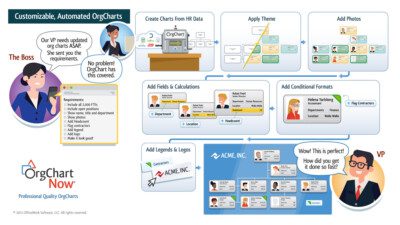Automating Org Charts for Success
Many companies we’ve teamed with over the years have made the change to an automated org chart and reaped the benefits despite being hesitant at first. What do we mean by “automate” exactly? There are several features of our org chart automation software that make chart creation simpler, faster AND more accurate:
Integration
No one likes data entry. And duplicating data manually into other environments is a waste of time. That’s why OrgChart partners with all the major HRM systems to ensure the smooth flow of data from system to chart. OrgChart provides direct import from your current Human Resource Information System (HRIS), Applicant Tracking System (ATS), payroll service, or spreadsheet via our “Connector” integrations.” Not only that, charts remain connected to the data source, meaning that changes are reflected in real-time.
Scalability
 Some of our clients work with thousands of employees. Not all tools can handle very large data sets. Maximum capacity of an org chart software should be carefully considered. Prepare for growth by starting with an automated solution. OrgChart arranges and formats the boxes of org charts automatically, which obviously becomes an increasingly difficult task to accomplish manually as the size of the organisation increases. When hundreds or even thousands of employees are being catered for, OrgChart is broken up into multiple pages which are easily navigated using an interactive PDF or PowerPoint.
Some of our clients work with thousands of employees. Not all tools can handle very large data sets. Maximum capacity of an org chart software should be carefully considered. Prepare for growth by starting with an automated solution. OrgChart arranges and formats the boxes of org charts automatically, which obviously becomes an increasingly difficult task to accomplish manually as the size of the organisation increases. When hundreds or even thousands of employees are being catered for, OrgChart is broken up into multiple pages which are easily navigated using an interactive PDF or PowerPoint.
Real-time Data
HR professionals are well aware of the dynamic nature of employee data because change is constant in the modern workplace. Manual org charts are often outdated by the time they are published and shared. With OrgChart workforce visualisations, charts update by re-querying source data to reflect changes such as supervisor changes, title changes and job exits. Charts are updated with a single click.
Conditional Formatting
An important consideration in the visualization of data is highlighting key aspects of a chart. For example, during a hiring push, vacant positions would want to be clearly visible. By using data driven rules and applying conditional formatting to key data points, such as color coding of vacant positions, decision making is made easier. Stakeholders involved in more complex HR strategy save time by immediately being drawn to the important message of the chart.
Case Study
A large automotive manufacturer, with over 135k employees and 500 HR managers, turned to our solution to automate their org charts after identifying debilitation weaknesses in their process. Those responsible for producing org charts used various draw tools such as Visio, PowerPoint, Excel and Lucidchart to name but a few. Thousands of man hours were spent manually creating and updating org charts. Management was frustrated with the inconsistent, inaccurate, and low quality of work being produced across the company. After consulting with our experts, data already stored and maintained in the Workday enterprise management system they used was integrated with OrgChart. Org charts were now being generated in seconds and standardized across the organisation (common colors, logos, formulas, conditional formats etc.) The result was accurate, consistent, real-time visualisations of their massive organisation saving hours of time compared to the way things were previously done.
A Solution For Every Company
Creating and maintaining org charts instantly from existing HR data saves time and money at all stages of the process. Begin a free trial of OrgChart today, or schedule a demo with one of our experts, to find out how OrgChart creates valuable charts from a variety of HR data sources.





